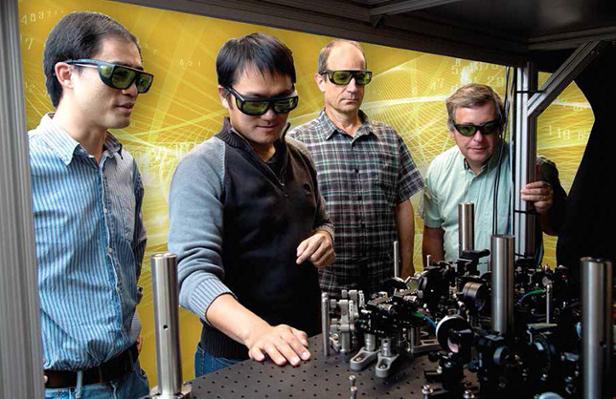
A Purdue Team Plans to Create the Tools to Test a Principle of String Theory
By Matt Schnepf and Elizabeth Gardner
Purdue physicists have a plan to achieve something previously thought impossible — a laboratory experiment to detect emergent spacetime and prove a principle prediction from string theory.
Through the creation of both a new material and apparatus, the team hopes to show how an analog of space and time can emerge from the collective behavior of a system of strongly interacting quantum particles, a phenomenon known as emergent spacetime.
Although scientists and philosophers have long debated this idea, testing it requires tools that don’t exist. Now, thanks to a $1 million grant from the W.M. Keck Foundation, a team of researchers from the Department of Physics and Astronomy hopes to make such testing possible.
“The foundation wants to kick-start this project,” says Chen-Lung Hung, an assistant professor of physics and astronomy, who leads the team. “They know this is high-risk, high-reward. The findings could lead to a new understanding of space, time and dimensionality as well as provide insights into quantum computing and quantum information theory. This grant will help us take the first step.”
String theory is a mathematical description that applies to all forces and matter, a so-called “theory of everything.” It includes a description of how gravity functions for subatomic particles — a missing piece in the standard model of particle physics — and strives for the unification of gravity with all other forces.
Hung will collaborate with professors Sergei Khlebnikov, Luis Martin Kruczenski and Qi Zhou. They will create a comprehensive test for many phenomena discussed in the so-called Anti-de Sitter/ Conformal Field Theory correspondence, a large research area in string theory.
“We are trying to connect string theory with an experiment — not a fundamental string theory, but using the same mathematics of string theory,” Kruczenski says.
Ultimately, the team hopes to determine whether collective dynamics in a strongly coupled quantum material can be described by emergent spacetime, a theory of quantum gravity.
The description of gravity from Einstein’s theory of general relativity states that space and time are curved around massive objects, which results in the deflection of particles and is called gravitational force. String theory proponents suggest that a curved spacetime can be a reflection of quantum entanglement, a dependent state formed among the particles such that what happens to one instantaneously affects the others. When this entanglement occurs, the quantum state of any individual particles can be described only in reference to the others. In the string theory of quantum gravity, this entanglement is what dictates the spatial geometry attributed to gravitational force.
“Testing this idea of an emergent spacetime and gravity demands a highly accessible, strongly coupled quantum material that provides complete spatiotemporal control of relevant system parameters to induce and detect collective dynamics with high precision,” Hung says.
“Ultracold atoms trapped in an optical lattice formed by intersecting laser beams are the most promising candidates, because that allows us to control almost all parameters, including atomic interaction, mobility, chemical potential and temperature to carry out the test,” Hung says.
The researchers will combine their theoretical and experimental skills to produce a novel experimental testing ground. Since 2016 Hung has been developing a quantum gas system with the potential to perform the proposed experiment. Zhou studies theory of many-body phenomena in quantum gases, and Khlebnikov and Kruczenski research string theory and its application to quantum matter.
String theory originally sought to explain why the universe exists as we see it today. The theory proposes that the building blocks of matter are tiny vibrating strings and that different vibrations and configurations lead to what currently have been identified as particles. The theory requires multiple additional small spatial dimensions beyond those currently known. According to Kruczenski, there generally has been no direct correlation between string theory and an actual scientific experiment.
Hung also believes Purdue’s proposal stood out by indicating the quantum particles and their behavior would actually appear how scientists have anticipated gravity to be in the higher dimensions predicted by string theory.
As a result, the researchers believe this will help close the gap that has persisted for decades between theoretical ideas from string theory and experiments. This particularly excites Kruczenski, since most of his work lies within the theoretical realm.
“Suddenly, there is an opportunity to collaborate and see where the mathematics — this idea — can become a reality,” he says. “I think that’s something the foundation liked.” In the laboratory, for example, researchers can now create quantum materials that could likely be explained using string theory, especially as the constituent particles strongly interact and develop correlations.
“Properties of such materials are difficult to address in theoretical physics, but string theory has a tool that has been developed to tackle this kind of problem,” Hung says. “So, one of the goals of this project is to create such material using ultracold atoms confined in a lattice formed by light, where the atoms inside it are strongly coupled to one another, and to study how these atoms behave under external perturbations.”
The team will compare its findings to an effective model developed by string theory to determine whether it can be used to describe the observed behavior.
“Upon experimental verification, we will be able to see, in a laboratory, the emergence of new local spatial dimensions and related gravity phenomena,” Hung says. “We hope our results will uncover new universal properties of strongly coupled systems and influence various disciplines, such as high-energy physics, gravitational physics and material sciences.”
John Finley, head of Purdue’s Department of Physics and Astronomy, believes the research being pursued under the Keck grant provides an interesting cross section between theoretical physics and experimental atomic, molecular and optical physics. He says, “It is a unique approach to fundamental problems that has the potential to make progress in the area of complementarity and provide a road sign for the way forward.”